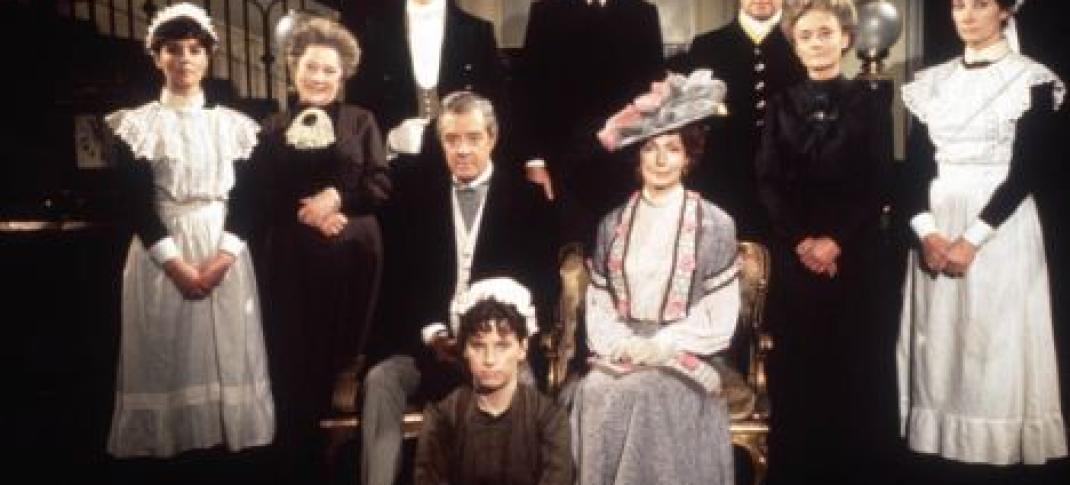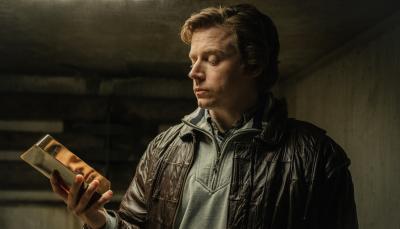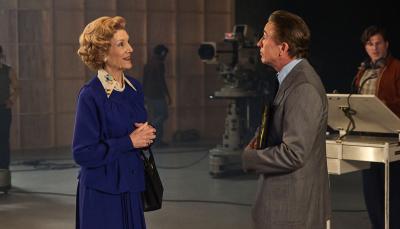Dated or Delightful? 'Upstairs Downstairs'

Upstairs Downstairs 1986 David Laangton and Racchel Gurney (Richard and Lady Marjorie Bellamy), centre, with their staff, clockwise from left, Pauline Collins (Sarah), Angela Baddeley (mrs Bridges), George Innes (Alfred), Gordon Jackson (Mr Hudson), Brian Osbourne (Pearce), Patsy Smart (Miss Roberts), Jean Marsh (Rose) Evin Crowley (Emily) REF NO : 61010TV MUST CREDIT : TVTIMES / SCOPEFEATURES.COM FOR EDITORIAL USE ONLY
TVTimes
In this installment of Dated or Delightful, I take on one of the most beloved of all British period dramas, the original Upstairs Downstairs. This BAFTA, Emmy and Golden Globe-winning series ran on the UK’s ITV network from 1971 to 1975 and was later broadcast on PBS’ Masterpiece Theatre. Forty-five years later, does the phenomenon that entertained over a billion people world-wide still hold up or are these stories of a bygone age of masters and servants hopelessly dated?
It must be acknowledged from the outset that a costume drama, if done well, will almost always stand up because the audience goes in expecting to be transported to another time. Antiquated social views, language, fashions, etc. are accepted because the audience knows the creators are just telling it like it was or even making a point about how much attitudes have changed since the period they are depicting in history.
As a newcomer to Upstairs Downstairs, I had a lot to learn about the inhabitants of 165 Eaton Place. What follows are my impressions of the look, the characters and the tone of the first series of this classic drama set in that now famous Belgravia neighborhood of Edwardian era London.
The first thing that would catch anyone’s attention while watching series one specifically is that some episodes were in black-and-white while others were filmed in “brilliant technicolor". According to Wikipedia this had to do with “an industrial dispute over extra payments for using newly introduced colour equipment. Broadcasting unions refused to allow their members to use colour cameras (during negotiations) so the first six episodes of the first series were shot in black-and-white. When colour production resumed, the first episode was remade in colour.” While those early installments certainly have a more old-fashioned feel, in the totality of a 68 episode series, a handful of black-and-white episodes might just be considered a vintage quirk.
You also can’t help but notice the more theatrical sensibility of Upstairs Downstairs. For example, scenes tend to last longer than the modern viewer might be accustomed to. Sets can be sparse and characters take more pauses and often speak in complete sentences. In fact, I have noticed multiple tiny line flubs that were just left in rather than reshooting the scene. After all there’s no opportunity for do-overs on stage, though more likely it was a matter of tight budgets.
Despite these production and style concerns, I found Upstairs Downstairs to be an engaging drama that portrays the class and gender gaps of the early 1900’s whilst illuminating timeless family and social issues. In the first series alone, the subjects touched on include marital infidelity, poverty, abortion, suicide, homosexuality and mental illness. These universal topics serve to transform a mere historical costume series into relatable domestic drama.
In fact, co-creators Eileen Atkins and Jean Marsh (who also portrayed house parlormaid, Rose Buck) came up with this unique concept after watching the ITV mini-series The Forsyte Saga. According to Ms. Atkins, "We enjoyed it enormously, as everybody else did. But we said, 'Yes, but our poor parents would have been ironing those frocks and blacking those grates and washing up all that stuff, and wouldn't it be wonderful if there was a series about the downstairs people? And originally it was just going to be about downstairs. And then we realized you couldn't have downstairs without upstairs so we had to let the rich people in."
The final argument I would make for the lasting appeal of Upstairs Downstairs is that four decades after its broadcast a similar program came along and took the world by storm all over again – albeit a faster paced, high gloss version of its forerunner. I have to admit, for someone like me so late to the world of the Bellamy family and their household staff, I was surprised at the number of similar situations and characters I encountered between Upstairs Downstairs and Downton Abbey.
For instance, I didn’t expect to meet another Mrs. Patmore in the demanding but maternally kind-hearted cook, Mrs. Bridges (Anglea Baddeley). Oddly enough, both ladies had a crisis regarding vision problems. Nor did I know that that Thomas Barrow had a predecessor in the Bellamys’ initial footman Alfred (George Innes). Unfortunately for Alfred his master wasn't as forgiving as Lord Grantham and so when his hookup with a male house guest came to light, his immediate departure was required. Another example is devoted butler Mr. Hudson (Gordon Jackson), the stern head and moral compass of the Eaton Place servant staff. Though Downton’s Mr. Carson had a larger household to supervise, Mr. Hudson performed his duties with the same decorum and perhaps a bit more realistic opinion of his employers.
Some of the upstairs inhabitants are familiar as well. Elizabeth Bellamy (Nicola Pagett), daughter of Richard (David Langton) and Lady Marjorie (Rachel Gurney), is a headstrong young woman concerned about the inequalities and conditions suffered by the working class poor. Though a bit more mischievous than Sybil Crawley, they both have the same modern, liberal spirit and seek out men who share their views.
So how do you see it? Is Upstairs Downstairs stale or satisfying? Do you still find it entertaining or does it bring about air of ennui particularly with the advent of the more glamorous melodrama of Downton Abbey? Have your say in the comments section below. And if you’ve never experienced this critically acclaimed television program, you can stream the complete series on Acorn TV.



